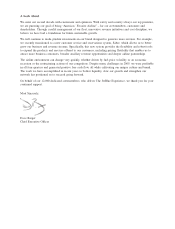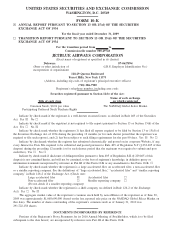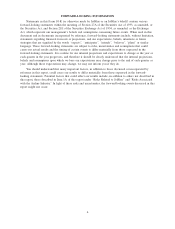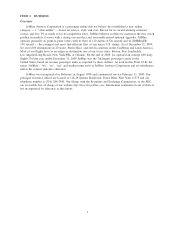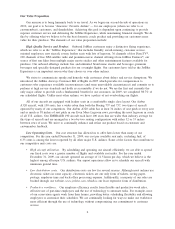JetBlue Airlines 2009 Annual Report Download - page 14
Download and view the complete annual report
Please find page 14 of the 2009 JetBlue Airlines annual report below. You can navigate through the pages in the report by either clicking on the pages listed below, or by using the keyword search tool below to find specific information within the annual report.
service, routes served, flight schedules, types of aircraft, safety record and reputation, code-sharing
relationships, capacity, in-flight entertainment systems and frequent flyer programs.
Our competitors and potential competitors include traditional network airlines, low-cost airlines, and
regional airlines. Six of the other major U.S. airlines are generally larger, have greater financial resources and
serve more routes than we do. Our competitors also use some of the same advanced technologies that we do
such as laptop computers in the cockpit and website bookings. In recent years, the U.S. airline industry
experienced significant consolidation, bankruptcy protection, and liquidation largely as a result of high fuel
costs and continued strong competition. In 2009, numerous smaller airlines around the world ceased operations
and other larger international carriers faced bankruptcy. Additionally, the merger of Delta and Northwest
created the world’s largest airline. Further industry consolidations or restructurings may result in our
competitors having a more rationalized route structure and lower operating costs, enabling them to compete
more aggressively.
Price competition occurs through price discounting, fare matching, increased capacity, targeted sale
promotions and frequent flyer travel initiatives, all of which are usually matched by other airlines in order to
maintain their share of passenger traffic. A relatively small change in pricing or in passenger traffic could
have a disproportionate effect on an airline’s operating and financial results. Our ability to meet this price
competition depends on, among other things, our ability to operate at costs equal to or lower than our
competitors. All other factors being equal, we believe customers often prefer JetBlue and the JetBlue
Experience.
During 2009, most traditional network airlines began to reduce capacity on their international routes
while continuing to reduce overall domestic and Caribbean capacity by redeploying the capacity to more
regional routes. Virgin America continued to expand in routes that compete directly with us, although other
carriers substantially reduced capacity in a number of our markets. We are encouraged by continued capacity
discipline across the industry and expect it to continue through 2010 which we believe will help offset the
impact of the recessionary environment.
Airlines frequently participate in marketing alliances which generally provide for code-sharing, frequent
flyer program reciprocity, coordinated flight schedules that provide for convenient connections and other joint
marketing activities. These alliances also permit an airline to market flights operated by other alliance airlines
as its own. The benefits of broad networks offered to customers could attract more customers to these
networks. We currently participate in marketing alliances with Deutsche Lufthansa AG, one of the world’s
preeminent airlines and our largest shareholder; Cape Air, an airline that services destinations out of Boston
and San Juan, Puerto Rico; and Aer Lingus, an airline based in Dublin, Ireland.
Route Network
Our operations primarily consist of transporting passengers on our aircraft with domestic U.S. operations,
including Puerto Rico, accounting for 89% of our capacity in 2009. The historic distribution of our available
seat miles, or capacity, by region is as follows:
Capacity Distribution 2009 2008 2007
Year Ended December 31,
East Coast – Western U.S. ......................... 34.7% 41.5% 47.4%
Northeast – Florida ............................... 32.8 33.9 31.8
Medium – haul .................................. 3.5 3.0 2.8
Short – haul .................................... 7.7 7.6 7.4
Caribbean, including Puerto Rico .................... 21.3 14.0 10.6
Total . ........................................ 100.0% 100.0% 100.0%
5


